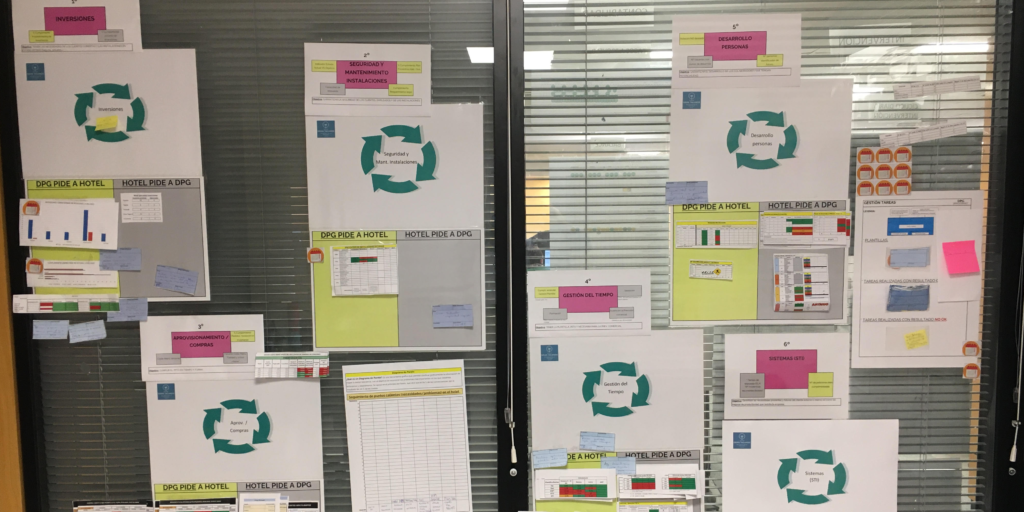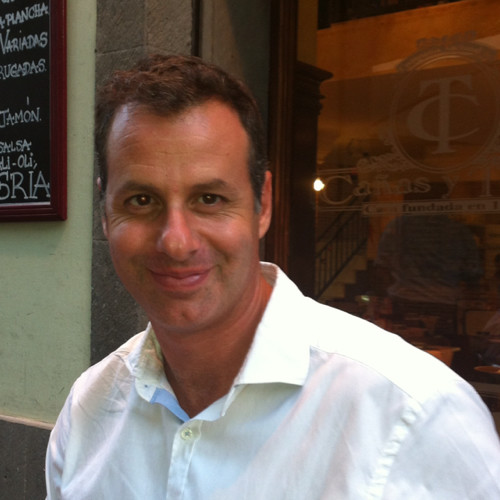Arrows and Loops – The Evolution of Our Management System
Mar 6, 2023

FEATURE – A senior executive of a Spanish hotel chain shares an example of how the organization’s management system and visual tools have changed over time.
Words: Jordi Estalella
As an organization develops its ability to identify and solve problems and becomes more mature in its understanding of Lean Thinking, it is only natural that it’s management system – and visual management supporting it – should also evolve. This is our experience at the Dreamplace Hotels & Resorts.
Our week starts with what we call the “newscast”, the weekly meeting that aims to ensure the correct functioning of our seven hotels. Representatives from each department provide the team with a short update on happenings and problems from their area and any “red” (problem) that is highlighted is then assigned to an ad-hoc team that is expected to solve it by a certain date. This is the tool we use to ensure things flow smoothly across departments, from sales to IT and maintenance.
The great advantage of this management tool is that it provides us with a snapshot of what’s going on across the organization, at a group level, without getting into too much detail on each corrective action. That’s why we call it the newscast. It’s a great tool but it is a bit lacking when it comes to finding out what goes on in each specific hotel. That’s why we then need to zoom in on each of the sections of the value stream (we call “flecha” or “arrow”) to go deeper into each area of the business and the problems they experience. For example, in the Sales Department, we have our own “arrow” that allows us to distribute all the information and ensures no problem falls through the cracks (it avoids cherry-picking in solving sales problems, too).
Parallel to the group’s arrow, we have another huge – and somewhat intimidating – board we call the Hotel Tube. It strives to bring together two realities: the macro-KPIs of the group and the individual micro-KPIs of the hotels. Each lane corresponds to a hotel, while columns represent multi-functional working areas that cover a step in the guest’s journey. In other words, the Hotel Tube follows the guest’s journey through our process. It generates great conversations and a huge amount of very useful data, but – again – it’s not great at zooming in and getting traction on countermeasures. When you have such a gargantuan board to look at and so many problems popping up all over the place, focusing on what truly matters can be hard. That’s when the next iteration in our management system appeared.
PROBLEM-SOLVING IS A TWO-WAY STREET
With the Hotel Tube, we found there was a big disconnect between the group’s arrow and hotels’ and realized we needed a management tool that would bring these two worlds together. Enter the loops (bucles in Spanish), which aim to enable real interaction between the group and the hotels to solve problems together (especially short- and medium-term ones).
We are still in experimentation, trial-and-error mode and, for now, we have only activated six loops – Sales, Investments, Safety and Maintenance, Time Management, IT, and People Development. Our goal is to make the loops more and more agile, to become faster at tackling the “reds” and gradually inject dynamism to the Hotel Tube (which they aim to eventually replace). What makes the loops so effective is that they recognize that it is all about the conversations: the guest’s journey, mapped in the Hotel Tube, is always at the heart of our discussions, of course, but the loops enable us to keep our focus on the actions we need to take to generate the value our guests expect.
Let me share a couple of examples of how the loops work. First, let’s look at the Investments loop. As a group, we of course have a plan of investments, but there was no visibility in the different hotels on when each investment was planned and, therefore, no real structure to the deployment of the investment. With the loops, not only do we have clear information on structured investment plans that are shared quarterly with all hotels, but also a way to communicate with them to ensure the investment can be made in the most efficient way possible. Imagine one of our hotels is asking the group for a certain investment – “We need new mattresses in 50 of our rooms”. With the loops, we are able to approve that investment while asking the hotel to lay down the groundwork – for instance, “We will replace the 50 mattresses, but I will need you to block those rooms for two days”. Another example is the IT loop, which has proved very useful to prioritize tickets and better manage IT jobs across the hotels (Wi-Fi is ongoing issue is some of them). This minimizes the cost of analyzing the problem and the “communication noise” that is generated by the deluge of calls and emails that we previously relied on to align on an action plan.
Every week, the hotel directors gather all the data from their hotels (sometimes we help them from Corporate, because we measure a lot of KPIs centrally), all the problems that occurred, all the open tickets, and the input from their area managers. For each problem, a corrective task is launched within the loop conversation – to ensure communication remains a two-way street. We are investing quite a bit in digitalization, to support data gathering and analysis – not with the goal of replacing our visual management paper boards, but to feed them.
Currently, the newscast and the department “arrow” meetings take place on a Monday – to start off the week with a clear idea of the situation – and the subgroups that are tasked with solving the problems take the rest of the week to do it. If we can become more dynamic in capturing and analyzing data and ensure smoother interaction between the group and the hotels, we can shorten that improvement cycle and become more agile in our problem-solving as an organization. This is ultimately the idea behind the loops.
THE AUTHOR

Jordi Estalella is Marketing and Sales Director, Dreamplace Hotels & Resorts.
Original Article: https://planet-lean.com/arrows-and-loops-the-evolution-of-our-management-system/
Stay In Touch.
Subscribe to our newsletter and exclusive Leadership content.
We respect your privacy and won’t spam your inbox
